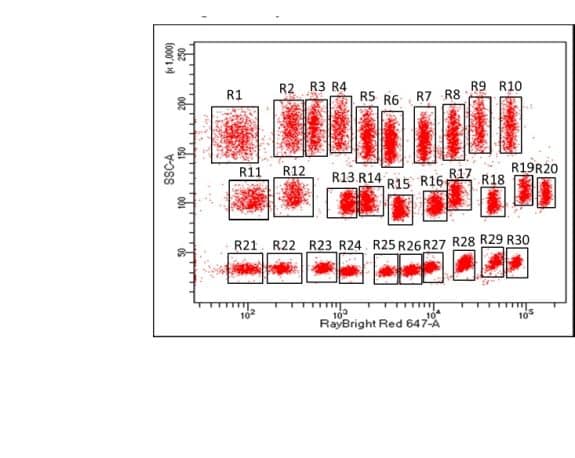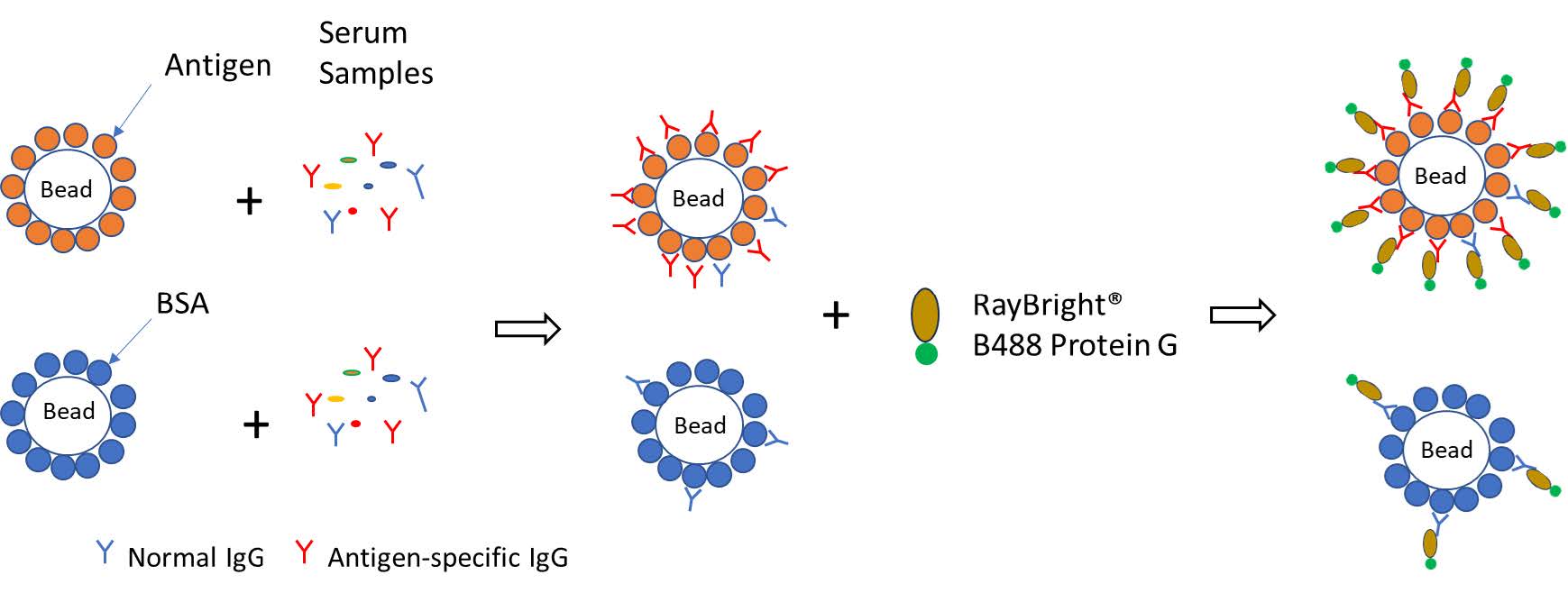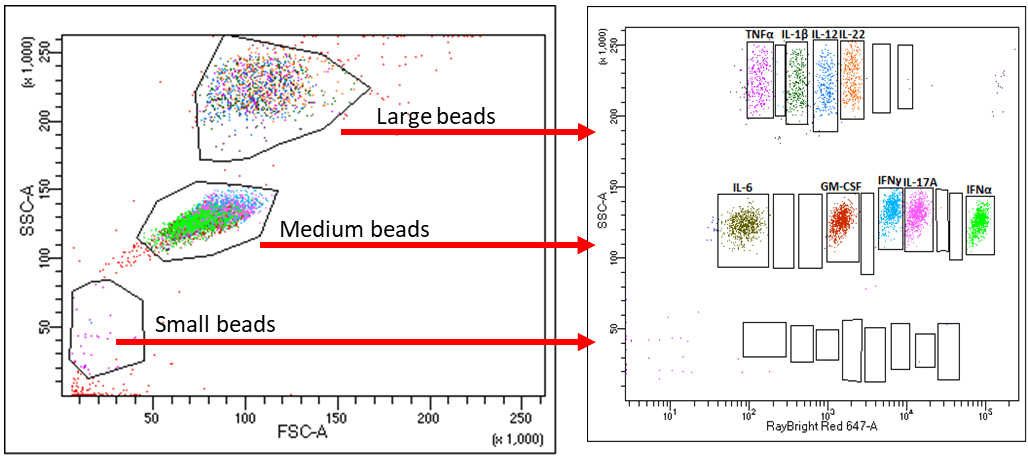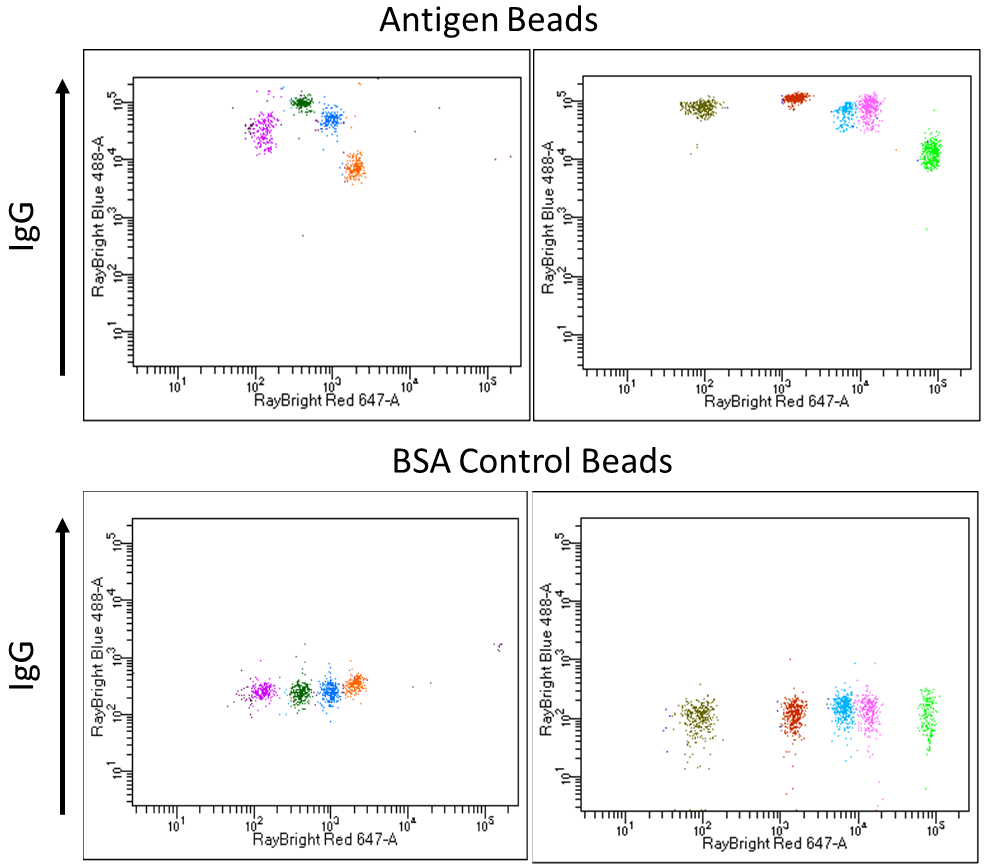
Custom RayPlex® Cytometric Bead Antigen Array
Design a personalized cytometric bead-based antigen array for antibody profiling
The custom RayPlex® antigen arrays are quantitative multiplex cytometric bead arrays (CBA) used for the simultaneous detection of multiple antibodies using very small sample volumes. Using antigens (proteins, lipids, or nucleic acids) immobilized onto microspheres, specific antibodies in the sample can be captured, bound by fluorochrome-conjugated protein G, and detected in the APC channel of any flow cytometer.
Antigen arrays are often used for detecting autoantibodies, antibody responses against tumor antigens, or host response to microbial antigens. Other applications include determination of antibody specificity, serologic antibody testing and evaluating adverse effects against a therapeutic protein. A quantitative, specific methodology for profiling antibody-antigen interactions, antigen array technology is particularly useful for autoimmune disease research, drug and vaccine development, and infectious disease testing.
Customize your own CBA panel by choosing from RayBiotech’s vast antigen library, and we’ll build a custom array kit and a tailored analysis tool with a 5-parameter logistical curve fitting function. Don’t have a flow cytometer? Opt for our comprehensive testing service and leave the array processing and data analysis to us!
Features
- Quantitative: kit includes a customized standard antibody cocktail for calibration
- BSA-coated beads are used to subtract nonspecific signals.
- No dedicated equipment needed: the array is compatible with most flow cytometers (requires red and blue lasers).
- Custom analysis tool included for easy signal calibration with 5PL regression.
Create Your Own Panel & Format
Customize the protein list
Choose from our catalog of over 1,800 in stock, purified human, and mouse proteins; send us your proteins; or we can make your proteins in-house. Our comprehensive recombinant protein service does it all, from gene synthesis to aliquoting.
Customize the format
RayBiotech can create a custom antigen array on a standard 96-well plate to meet your research needs. Depending on the number of proteins needed, multiple panels can be designed with up to 30 targets per panel. For example:
≤ 30 proteins bead-conjugated, 40 samples analyzed on one 96 well plate
≤ 60 proteins bead-conjugated, 40 samples analyzed on two 96 well plates
≤ 90 proteins bead-conjugated, 40 samples analyzed on three 96 well plates
> 120 proteins bead-conjugated, 40 samples analyzed on four 96 well plates
How It Works
This RayPlex array is first prepared by immobilizing antigens onto small beads of different sizes containing different fluorochromes, where there is only one target's antigen per bead size-fluorochrome combination (Antigen-Beads). Corresponding Beads conjugated with the same amount of BSA serve as control beads to evaluate non-specific antibody binding (BSA-Beads). The Antigen-Beads bind to their specific antibodies during sample incubation, and unbound antibodies are removed with washing. The BSA-Beads bind to non-specific antibodies. Then, the RayBright® 488 conjugated protein G is added, thus enabling antibody detection via the RayBright 488 - Protein G - Antibody complex. The RayBright 488 Mean Fluorescence Intensity (MFI) reading of the Antigen-Beads minus the MFI of the BSA-Beads reflects the amount of antigen-specific antibodies in an unknown sample. The antibody amount can be quantified by comparing the RayBright 488 signal to a standard curve generated from antibody standards at known concentrations.

Multiplex Bead Array Detection of Antibodies

Determination of Positivity Based on MFI Ratio Between Antigen Beads and Control Beads

Discuss your project requirements
Frequently Asked Questions
Still have questions?
Common flow cytometer equipped with blue and red lasers.
Send us your samples, we will develop the kit and send you the results.
Most of our arrays are compatible with any biological fluid. This includes cell culture media, cell lysates, tissue lysates, and all clarified body fluids (serum, plasma, urine, cerebrospinal fluid, BAL, saliva, tears, etc.)
Intra-assay precision is accomplished by running standards and samples in duplicate measurements. The standard will take 16 tests. To determine the number of tests your experiment needs, simply calculate the number of samples you have, double that number and then add 16.
Still have questions?